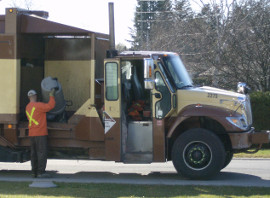Stephen Vance, Staff

While the 57.3 percent diversion rate achieved last year is lower than Meaford’s peak diversion rate of slightly more than 60 percent, Meaford’s Director of Development and Environmental Services, Rob Armstrong, told council that reduction is in part due to adjustments made to how Waste Diversion Ontario (WDO) calculates diversion rates.
“To summarize the 2015 curbside capture rates, the Municipality has maintained its curbside diversion rate at approximately 57.3% (2014 results) as calculated by Waste Diversion Ontario (WDO). This is lower than previous years and is a result of WDO adjustments of Municipality of Meaford data,” noted Armstrong in his report. “To ensure that residential waste diversion rates are calculated accurately and fairly amongst municipalities, WDO adjusts material quantities reported by some municipal programs. For example, WDO makes adjustments where disposal tonnages are missing or where tonnages are significantly out of range relative to similar programs. While the Municipality continues to strive towards the provincial goal of 70% diversion, it should be noted that this will become increasingly challenging due to the strong programs in place, with limited opportunities to expand.”
In 2015 Meaford saw a nearly 20 percent increase in curbside organics collection from 339.9 tonnes collected in 2014 to 407.6 tonnes collected last year.
Recyclable tonnage was down slightly from 864 tonnes in 2014 to 827 tonnes in 2015, which Armstrong suggested is possibly related to lighter packaging materials being used by manufacturers, who have been shifting away from heavy materials like glass to lighter materials like plastic in recent years.
The amount of garbage collected curbside in 2015 continued to decline with 760 tonnes collected compared to 780 tonnes in 2014.
Also helping to drive Meaford’s impressive waste diversion numbers are programs for collecting hazardous household waste, electronic waste, and yard waste.
“The 2015 Household Hazardous Waste program included the disposal of hazardous waste by 326 municipal residents (382 equivalent loads), allowing residents to dispose of hazardous materials in an environmentally friendly method. As a result of a strong HHW program, the Municipality once again paid $25 per load ($9,550 in total) and received $7,7443.74 back from Stewardship Ontario through the City of Owen Sound which operates the program. This pricing structure will remain in effect for 2016,” noted Armstrong in his report. “The E-Waste program, a collaboration between the Municipality and Grey-Bruce Habitat for Humanity, continued to be successful in 2015, with strong participation and positive feedback. Over the course of 2014, the E-waste recycling program diverted 22,680 kg of electronic waste and 252 kg of used batteries. The Leaf and Yard Waste facility continues to be a popular service provided by the Municipality. During 2015, just over 6,600 vehicles disposed of their leaf, garden waste, and brush, with a small portion of this group purchasing wood-chips, compost, or mulch. The materials collected on-site are utilized in determining the Municipality’s overall waste diversion rate.”
Armstrong noted that any future gains to be realized in the effort to reach the 70 percent waste diversion goal set by the province will likely be found by individual residents.
“Future expansion of the capture rate will have to begin ‘at home’, with residents increasing their participation rate to increase waste diversion (i.e. conscious selection of goods, and in-home recycling and composting),” suggested Armstrong.
In 2015, the Municipality tendered all of its curbside waste and recyclables collection including Municipal facility front end waste bins. Bids were received and Miller Waste Systems was successful in obtaining the curbside collection and several enhanced collection items. The contract is for a term of five years.
“The collection enhancements were directly due to the closing of the Meaford Transfer Station on September 30, 2015. The enhanced collection included curbside collection of film plastic, styrofoam, kitty litter in the organic stream as well as implementing a ‘Bulky Item’ collection for larger items. The Municipal garbage bin contract was awarded to Waste Management Inc. and included optimization of the overall number and location of the Municipal bins to reduce costs,” noted Armstrong.
Armstrong told council that for the coming year municipal staff will focus on the following opportunities to improve its waste management system, and to continue striving toward the 70 percent waste diversion goal:
-
Continued monitoring of capture rates of all waste collection programs.
-
Continued development of a strong public education program, which will include: working with local schools to promote waste diversion, attending local special events and outreach programs, and general public awareness. The program will use Meaford’s recycling bin mascot, ‘BIG BLUE’, in conjunction with a partnership with Town of the Blue Mountains and their green bin mascot ‘Binjiman’ as a method of residential engagement towards waste diversion programs or initiatives.
-
Continued development of multi-residential recycling and organic collection through specific plans suited to the facility.
-
Conduct a Blue Box audit to determine materials and residential participation rates both full-time and seasonal.
-
Continued development of efficient waste collection programs for seasonal residential areas through increased education on the proper use of roadside collection containers and collection signage.
-
Continue to seek any available funding to further enhance or subsidize existing programs.
-
Work with a group of residents who are proposing to implement a Zero Waste reward program for businesses.
-
Monitor the impacts of proposed Bill 141 on the Municipal Program.











